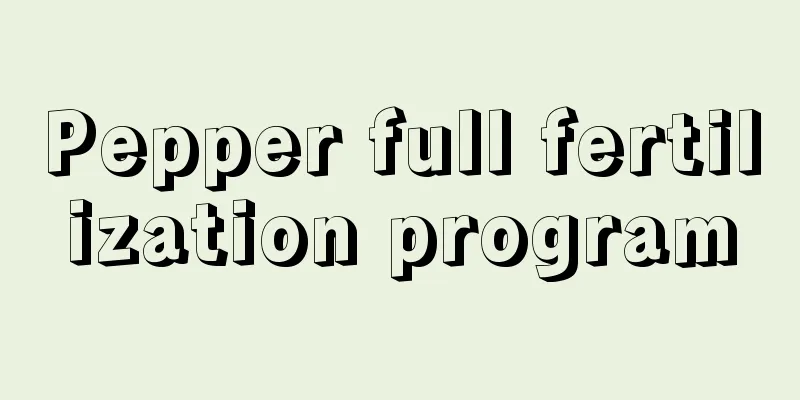Pepper full fertilization program

|
In China, peppers are grown all over the country, from north to south. Due to regional differences, different places have different preferences for the characteristics of pepper varieties. These preferences include the shape, spiciness, color and flesh thickness of the peppers, so pepper varieties in different regions vary accordingly. However, while variety selection may vary from place to place, pepper fertilization techniques are similar across the country. Let’s learn about the complete fertilization plan for peppers. 1. Fertilizer requirements of peppers Division of the growing period: The growing period of pepper is usually divided into the germination period, seedling period, flowering and fruiting period, and fruiting period. Fertilizer requirement ratio: The pepper's requirement ratio for nitrogen (N), phosphorus (P), and potassium (K) during the entire growing period is roughly 1:0.5:1. To produce 1000kg of peppers, approximately 3.5-5.4kg of nitrogen fertilizer, 0.8-1.3kg of phosphorus pentoxide, and 5.5-7.2kg of potassium oxide are required. Characteristics of fertilizer requirements at different stages: Germination period: Nutrient requirement accounts for 5% of the total absorption. Seedling stage: As growth accelerates, nutrient requirements increase to 11%. Flowering and fruiting period: Fertilizer requirement accounts for 34% of the total, with nitrogen fertilizer absorption being the highest. Fruiting period: Nutrient absorption accounts for 50% of the total, and the demand for phosphorus and potassium fertilizers increases. 2. Field planting fertilization plan Base fertilizer: Use balanced compound fertilizer as the main method and avoid using chlorine-containing fertilizers to meet the nutritional needs of peppers throughout their entire growth cycle. Seedling fertilizer: Mainly high-nitrogen and high-phosphorus compound fertilizer to meet the nutritional needs of peppers from sowing to transplanting. top dressing: After seedlings have grown, apply 8-11kg of Miaoliwang to meet nitrogen needs. Seedling stage: Flush with 10-15kg of medium-nitrogen and high-potassium water-soluble fertilizer , combined with medium-element water-soluble fertilizer. Before flowering and fruiting: apply 10-15kg of balanced compound fertilizer, such as 17-17-17 (sulfur-based). During the peak flowering and fruiting period: Apply 5-8 kg of pepper-specific fertilizer (14-5-26) every 15-20 days, and gradually reduce the dosage. Foliar topdressing: During the flowering and fruiting period, spray water-soluble fertilizers and potassium dihydrogen phosphate to increase the number of fruits and the quality of the fruits. 3. Key Management Technologies Select good varieties: Select suitable high-yield and high-quality varieties based on market demand, yield, disease resistance and stress resistance. Intertillage and weeding: In the middle growth period of pepper, timely break the film and carry out intertillage to promote the deep growth of the root system and prevent premature aging. Pest and disease control: Take appropriate prevention and control measures in a timely manner against diseases such as epidemics, wilt, and viral diseases. For major insect pests, such as aphids, cutworms, etc., use appropriate pesticides for prevention and control. Key points for field management: Reasonably control light, water and fertilizer conditions, and pay attention to the characteristics of peppers: they like light but are afraid of strong light, like moisture but are afraid of waterlogging, and like fertilizer but are afraid of fertilizer burn. In short, before planting peppers, understanding the fertilizer requirements and fertilization methods of peppers can effectively improve the yield and quality of peppers and achieve the goals of high yield, high quality and high efficiency in pepper planting .
|
<<: How to propagate trumpet creeper and in what season does it bloom
>>: What is trumpet creeper and how to grow it
Recommend
How to grow lentils on the balcony?
Planting environment Lentils prefer a warm and su...
How many days does it take for Nepeta to germinate after sowing?
Nepeta is a plant of the genus Nepeta in the fami...
Common diseases of Oncidium and their control methods
Oncidium leaf disease When Oncidium is infected w...
Can Cymbidium be grown in soil?
Can Cymbidium be grown in soil? Cymbidium can be ...
Can orange seeds be planted?
Can orange seeds be planted? Orange seeds can be ...
Can the Euphorbia obesa be inserted in water?
Water-inserted lotus The Euphorbia pulcherrima pr...
What is the best month to plant cherry tomatoes?
When to plant cherry tomatoes Cherry tomatoes are...
Characteristics of Dandelions
1. Appearance characteristics 1. The root system ...
How to grow Clivia in the south
Soil requirements The best potting soil for culti...
When does the cold orchid bloom?
1. Flowering period Generally, the flowering time...
Why do the leaves of the money tree turn yellow in autumn? How to save it
1. No fertilization 1. Reason: Autumn is the seas...
Lipstick flower cultivation methods and precautions
Soil selection for lipstick flower Lipstick flowe...
Snake gourd planting time and method
Snake gourd planting time Snake gourd likes to gr...
How to fertilize Osmanthus fragrans so that the leaves will be green and bright!
How to fertilize If you want to make Osmanthus fr...
When is the best time to plant plum blossom seeds?
Plum blossom seed planting time Plum blossom is a...









